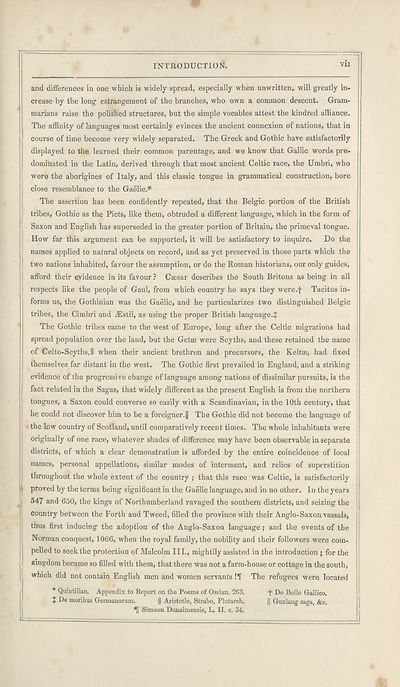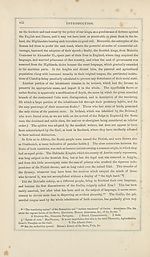Books and other items printed in Gaelic from 1871 to 1900 > Sar-obair nam bard gaelach, or, The beauties of Gaelic poetry, and lives of the Highland bards
(21) Page vii
Download files
Complete book:
Individual page:
Thumbnail gallery: Grid view | List view

INTRODUCTION.
and differences in one which is widely spread, especially when unwritten, will greatly in¬
crease by the long estrangement of the branches, who ow7n a common descent. Gram¬
marians raise the polished structures, but the simple vocables attest the kindred alliance.
The affinity of languages most certainly evinces the ancient connexion of nations, that in
course of time become very widely separated. The Greek and Gothic have satisfactorily
displayed to the learned their common parentage, and we know that Gallic words pre¬
dominated in the Latin, derived through that most ancient Celtic race, the Umbri, who
were the aborigines of Italy, and this classic tongue in grammatical construction, bore
close resemblance to the Gaelic.*
The assertion has been confidently repeated, that the Belgic portion of the British
tribes. Gothic as the Piets, like them, obtruded a different language, which in the form of
Saxon and English has superseded in the greater portion of Britain, the primeval tongue.
How far this argument can be supported, it will be satisfactory to inquire. Do the
names applied to natural objects on record, and as yet preserved in those parts which the
two nations inhabited, favour the assumption, or do the Roman historians, our only guides,
afford their evidence in its favour ? Caesar describes the South Britons as being in all
respects like the people of Gaul, from which country he says they were.f Tacitus in¬
forms us, the Gothinian was the Gaelic, and he particularizes two distinguished Belgic
tribes, the Cimbri and ^Estii, as using the proper British language.t
The Gothic tribes came to the west of Europe, long after the Celtic migrations had
spread population over the land, but the Getse were Scyths, and these retained the name
of Celto-Scyths,§ when their ancient brethren and precursors, the Keltse, had fixed
themselves far distant in the west. The Gothic first prevailed in England, and a striking
evidence of the progressive change of language among nations of dissimilar pursuits, is the
fact related in the Sagas, that widely different as the present English is from the northern
tongues, a Saxon could converse so easily with a Scandinavian, in the 10th century, that
he could not discover him to be a foreigner. || The Gothic did not become the language of
the low country of Scotland, until comparatively recent times. The whole inhabitants were
originally of one race, whatever shades of difference may have been observable in separate
districts, of which a clear demonstration is afforded by the entire coincidence of local
names, personal appellations, similar modes of interment, and relics of superstition
throughout the whole extent of the country ; that this race was Celtic, is satisfactorily
proved by the terms being significant in the Gaelic language, and in no other. In the years
547 and 650, the kings of Northumberland ravaged the southern districts, and seizing the
country between the Forth and Tweed, filled the province with their Anglo-Saxon vassals,
thus first inducing the adoption of the Anglo-Saxon language; and the events of the
Norman conquest, 1066, when the royal family, the nobility and their followers were com¬
pelled to seek the protection of Malcolm III., mightily assisted in the introduction ; for the
Kingdom became so filled with them, that there was not a farm-house or cottage in the south,
which did not contain English men and wmmen servants If The refugees were located
* Quintilian. Appendix to Report on the Poems of Ossian. 263. *)• De Bello Gallic©.
J De moribus Germanorum. § Aristotle, Strabo, Plutarch. || Gunlaug saga, &c,
If Simeon Dunelmensis, L. II. c. 34.
and differences in one which is widely spread, especially when unwritten, will greatly in¬
crease by the long estrangement of the branches, who ow7n a common descent. Gram¬
marians raise the polished structures, but the simple vocables attest the kindred alliance.
The affinity of languages most certainly evinces the ancient connexion of nations, that in
course of time become very widely separated. The Greek and Gothic have satisfactorily
displayed to the learned their common parentage, and we know that Gallic words pre¬
dominated in the Latin, derived through that most ancient Celtic race, the Umbri, who
were the aborigines of Italy, and this classic tongue in grammatical construction, bore
close resemblance to the Gaelic.*
The assertion has been confidently repeated, that the Belgic portion of the British
tribes. Gothic as the Piets, like them, obtruded a different language, which in the form of
Saxon and English has superseded in the greater portion of Britain, the primeval tongue.
How far this argument can be supported, it will be satisfactory to inquire. Do the
names applied to natural objects on record, and as yet preserved in those parts which the
two nations inhabited, favour the assumption, or do the Roman historians, our only guides,
afford their evidence in its favour ? Caesar describes the South Britons as being in all
respects like the people of Gaul, from which country he says they were.f Tacitus in¬
forms us, the Gothinian was the Gaelic, and he particularizes two distinguished Belgic
tribes, the Cimbri and ^Estii, as using the proper British language.t
The Gothic tribes came to the west of Europe, long after the Celtic migrations had
spread population over the land, but the Getse were Scyths, and these retained the name
of Celto-Scyths,§ when their ancient brethren and precursors, the Keltse, had fixed
themselves far distant in the west. The Gothic first prevailed in England, and a striking
evidence of the progressive change of language among nations of dissimilar pursuits, is the
fact related in the Sagas, that widely different as the present English is from the northern
tongues, a Saxon could converse so easily with a Scandinavian, in the 10th century, that
he could not discover him to be a foreigner. || The Gothic did not become the language of
the low country of Scotland, until comparatively recent times. The whole inhabitants were
originally of one race, whatever shades of difference may have been observable in separate
districts, of which a clear demonstration is afforded by the entire coincidence of local
names, personal appellations, similar modes of interment, and relics of superstition
throughout the whole extent of the country ; that this race was Celtic, is satisfactorily
proved by the terms being significant in the Gaelic language, and in no other. In the years
547 and 650, the kings of Northumberland ravaged the southern districts, and seizing the
country between the Forth and Tweed, filled the province with their Anglo-Saxon vassals,
thus first inducing the adoption of the Anglo-Saxon language; and the events of the
Norman conquest, 1066, when the royal family, the nobility and their followers were com¬
pelled to seek the protection of Malcolm III., mightily assisted in the introduction ; for the
Kingdom became so filled with them, that there was not a farm-house or cottage in the south,
which did not contain English men and wmmen servants If The refugees were located
* Quintilian. Appendix to Report on the Poems of Ossian. 263. *)• De Bello Gallic©.
J De moribus Germanorum. § Aristotle, Strabo, Plutarch. || Gunlaug saga, &c,
If Simeon Dunelmensis, L. II. c. 34.
Set display mode to:
![]() Universal Viewer |
Universal Viewer | ![]() Mirador |
Large image | Transcription
Mirador |
Large image | Transcription
Images and transcriptions on this page, including medium image downloads, may be used under the Creative Commons Attribution 4.0 International Licence unless otherwise stated. ![]()
| Permanent URL | https://digital.nls.uk/107578898 |
|---|
| Description | Out-of-copyright books printed in Gaelic between 1631 and 1900. Also some pamphlets and chapbooks. Includes poetry and songs, religious books such as catechisms and hymns, and different editions of the Bible and the Psalms. Also includes the second book ever published in Gaelic in 1631. |
|---|

